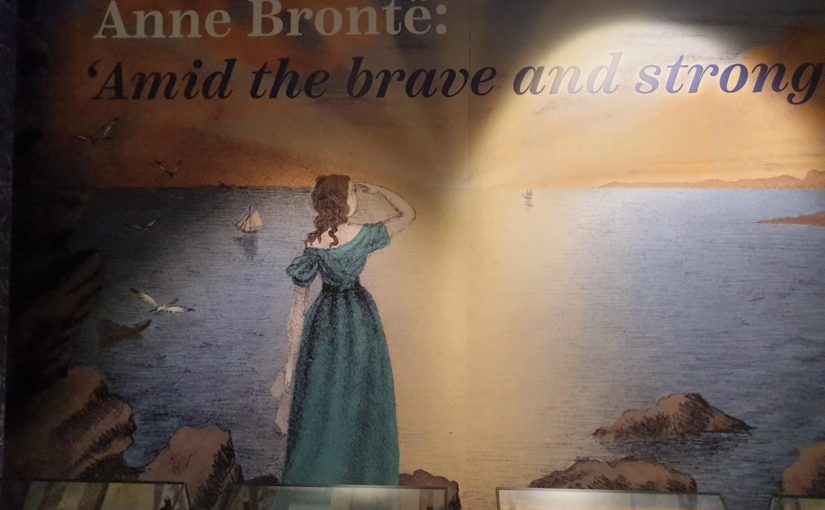This time last week I was in Haworth having a whale of a time, whilst also social distancing and keeping to all the rules and regulations of course. I finally had the opportunity to see the Brontë Parsonage Museum’s Anne Brontë exhibition entitled ‘Amid The Brave And Strong’, and I have to say that they have done Anne proud in her 200th birthday year.

I visited the Parsonage on her birthday in January, but at that time visitors were only allowed into the Bonnell Room (named after the museum’s great benefactor) adjacent to the shop. I had planned on visiting again much sooner than this, but of course this world wide pandemic had other ideas. The good news is that Anne’s bicentenary celebrations have been extended into 2021, but I know that for multiple reasons many of you will be unable to see this exhibition. I’ve therefore created this post showing pictures of Anne items on display throughout the main museum and within the special Anne Brontë exhibition in the Bonnell Room.
The Parsonage now allows visitors to take pictures within the museum, without the use of flash, so I’m delighted to be able to share my pictures with you, allowing you to take a virtual tour of ‘Anne Brontë: Amid The Brave And Strong.’ At the end of this post you’ll also find a link that will enable you to make a donation to the Brontë Parsonage Museum at this challenging time, after all every little helps. There are so many items to show that I’ve decided to split this ‘tour’ into two separate posts, so without further ado let’s commence the first part.
We’ll be taking a look purely at Anne Brontë items on display in Haworth’s Brontë Parsonage Museum at the moment, but of course there are treasures relating to all the family there. The first room that visitors enter is the Brontë dining room. It contains the couch upon which Emily took her final breath, but it also contains this magnificent dining table, around which Anne and her siblings walked as they shared ideas and plotlines and composed their works.

Let’s head upstairs now, passed the striking grandfather clock. One item that always grabs the attention on the first floor is Charlotte Brontë’s dress (different ones are displayed in different years), but take a look at the beautiful seashell necklace around the neckline – it was Anne’s. Anne loved to collect seashells and, as we shall see, she loved colourful, eye catching necklaces. The stockings on display here were also worn by Anne.

In this display case we have a selection of Anne’s art, with five of her drawings on show. I’m sure she wouldn’t mind Emily’s colourful portrait of Flossy, on the bottom left here, also being included.

Charlotte made three extant drawings of her youngest sister Anne (and there were possibly many more) but this one is my favourite.

Needlecraft was an essential skill for the Brontë sisters, both for the making and repair of their own apparel and so that they could teach it to others during service as governesses. Here we have Anne’s needlework kit, and the results of her labours – a beautifully crafted lace collar which she made for Charlotte.

Bobbins, buttons and bits of lace were in this tin box owned by Emily Brontë. Not the most exciting tin, you may think, but it held an exciting secret. In 1895 Arthur Bell Nicholls, Charlotte Brontë’s widow of course, found that it had a hidden compartment. When this was opened he found tiny scraps of paper with writing and drawing on them – these were the diary papers which Emily and Anne had written between 1834 and 1845 and then hidden away from the world. They were nearly lost for ever, so could more Brontë treasures still be hidden from sight, waiting to be discovered?

Here we have portraits made by Anne Brontë. The image on the right entitled ‘A very bad picture’ is, I believe, a self-portrait composed using the aid of a mirror. On the left we have a delightful portrait of one of Anne’s Robinson charges while she was a governess at Thorp Green Hall.

We now leave the parsonage that Anne and her family knew and enter the extension added to the building by Patrick Brontë’s successor Reverend Wade. At the bottom right is a first edition of Anne’s first novel Agnes Grey, published alongside Wuthering Heights by Thomas Cautley Newby. He was an unscrupulous publisher who treated his authors appallingly, but without him we might have had no Brontë novels today.

This wooden lion was obviously much loved by the Brontës, and as the youngest sibling Anne would have been the last to play with it. Also, just how delightful is this tea set used by the sisters, showing three young women enjoying a cuppa?

Anne’s needlework prowess is on show again, as this sampler was made by her just a month after her tenth birthday.

From the first time she encountered it in July 1840, Scarborough was a place that Anne Brontë loved. She collected pebbles and shells from its beach, and here are some of them. It’s fitting that Anne now lies at rest in Scarborough, overlooking the sea and sand that she adored.

The brooch on the left was Anne Brontë’s and the brooch on the right was Charlotte’s, and within the centres are locks of their hair.

We finish this portion of the parsonage tour with Anne and Charlotte’s hair once again. The bracelet at the back was fashioned from Anne Brontë’s locks, and the white bracelet at the front was made from Charlotte Brontë’s hair.

Next week we will head down the stairs and into the Bonnell Room which contains the main exhibition devoted solely to Anne in this, her special year. I will be bringing you each individual case in detail, and talking about what the items within tell us about Anne and her family. I hope you’ve enjoyed part one of this virtual tour of the Brontë Parsonage Museum in Haworth, and if you wish to donate directly to the Brontë Parsonage Museum itself you can do so via this link: https://www.bronte.org.uk/support-us/donate/2/general-donations
I hope you can join me next Sunday for part two of our virtual tour and our Anne Brontë celebration, and the good news is that there is no 10 PM curfew on reading this blog.

Thank you for this. It is fascinating to see items that I may not have the chance to see again. My visit to Haworth was in 1968 and I have been obsessed eversince! I am glad you were able to go and enjoy it, as well as sharing your visit with us.
Kate, it’s worth mentioning the Brontë Society’s publication Anne Brontë: “Amid the Brave and Strong”, in effect a book of the exhibition. It includes images of the exhibits and text from the accompanying labels. Although I had only a quick look at one in the museum’s shop, it seemed well worth owning a copy, especially if you’re unable to make the exhibition in person. You can buy it on-line.
https://www.bronte.org.uk/bronte-shop/biography/619/anne-bronte-amid-the-brave-and-strong
Thank you so much for this interesting and thoughtful wander around the Parsonage and exhibition.
I am a wheelchair user and so unable to get around much of the building. Your photos and words brought it very much to life – I really appreciate it.
Very thoughtful of you to post these images for those of us who can’t be in Haworth in person due to oceans, age or means or all of the impediments. Thx. Mel
Tha k you Nick – amazing and informative as always.